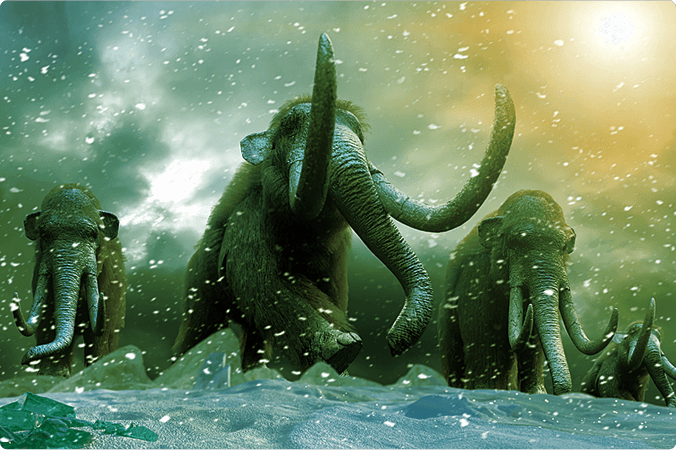
Mammoths consumed about 225 kilograms of plants, grasses, aquatic shrubs and trees daily. They used the tip of their sensitive trunks to pick and eat delicate buds, flowers and shorter grasses. Mammoths had four giant, shoe box-sized teeth — two upper and two lower.
Source: National Geographic
Mammoths mated and reproduced almost identically as that of modern day elephants. The gestation period is guessed to be about 22 months. They would only have one baby at a time, and in some cases only one baby in their whole life. It would take about 10-12 years to reach sexual maturity.
Source: Creation Wiki
Contrary to common belief, the woolly mammoth was hardly mammoth in size. Mammoths were about the size of modern African elephants. A woolly mammoth’s shoulder height was 9 to 11 feet tall and weighed around 6 tons. The Steppe mammoth was perhaps the largest one in the family — growing up to 13 to 15 feet tall.
Source: Ted Talks
Using their method and human genome sequences, the scientists estimated that our species has a ‘natural’ lifespan of 38 years; they also found that our extinct cousins, Neanderthals and Denisovans, probably lived around 37.8 years, and that woolly mammoths (Mammuthus primigenius) had a maximum lifespan of 60 years.
Source: Sci News
Humans hunted mammoths for their meat, bones and skin. Beside humans, mammoths were preyed upon by large cats such as the sabertooth, the European leopard panthera pardus spelaea, European and American lions, dire and Beringian wolves, short-faced bears and Cave hyenas.
Source: Quora
Modern elephants and woolly mammoths share a common ancestor that split into separate species about 6 million years ago, the study reports….Then just 440,000 years later, a blink of an eye in evolutionary time, Asian elephants and mammoths diverged into their own separate species.
Source: National Geographic



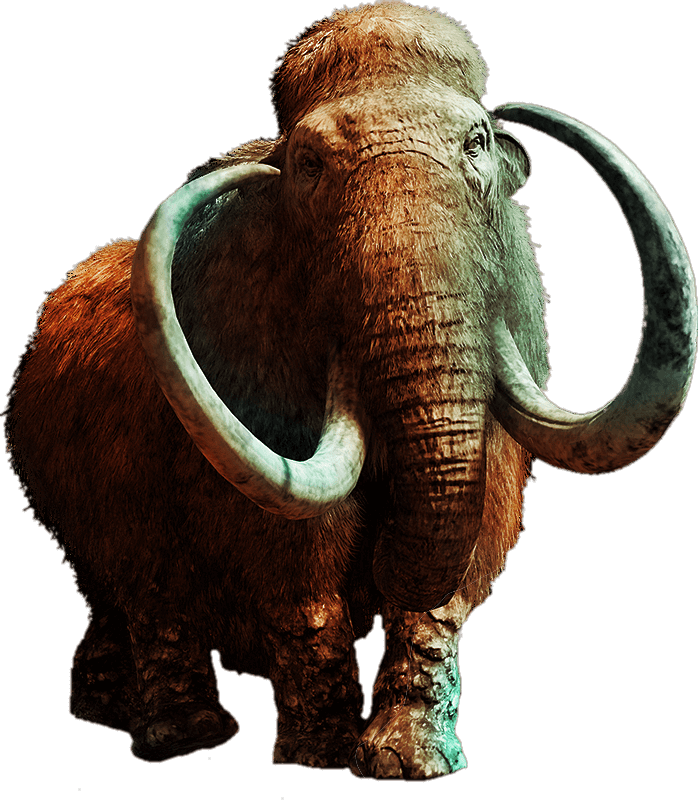

Mammoth Hair
Woolly mammoth had long, shaggy, light to dark brown or black coat and thick layer of fat.
Matriarchy
Woolly mammoth had lived and traveled in large family groups led by the oldest female.
Herbivore
Diet of woolly mammoth was based on the leaves, fruits, berries, nuts, and twigs.
Living Relative
A 2015 DNA review confirmed Asian elephants as the closest living relative of the woolly mammoth.
factoids
01 Tusks Were Up to 15 Feet Long
02 Memorialized in Cave Paintings
03 Covered With Fat as Well as Fur
04 Many Were Preserved in Permafrost
05 Cloning Might Be Possible
Source: Thought Co.
300,000 years of evolution
the mammoth lineage branched from the asian elephant around 6 million years ago
The earliest fossils are from mMammuthus meridionalis (southern mammoth), which gave rise to Mammuthus trogontherii (steppe mammoth), the largest mammoth to ever live. Then, around 300,000 years ago the woolly mammoth, Mammuthus primigenius evolved in Eastern Siberia. The woolly mammoth spread to North America over the Beringia Land Bridge. Slightly smaller than living African elephants, it thrived through many ice ages foraging on Steppe grasslands until 10,000 years ago when their numbers began to decline. The last woolly mammoths survived on Wrangel Island until about 4,000 years ago.
Source: Revive & Restore
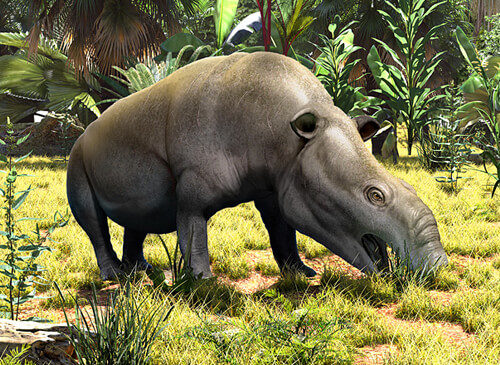
Weight: 200 lb. | Height: 2-3 ft | Range: North America, West Africa
Description
Moeritherium was a rotund semi-aquatic mammal with short, stubby legs that lived about 37-35 million years ago. Its body shape and lifestyle demonstrate convergent evolution with pigs, tapirs, and the pygmy hippopotamus. Moeritherium was smaller than most or all later proboscideans, standing only 70 centimetres (2.3 ft) high at the shoulder and weighing 235 kilograms (518 lb). The shape of their teeth suggests that they ate soft water vegetation. The shape of the skull suggests that, while Moeritherium did not have an elephant-like trunk, it may have had a broad flexible upper lip like a tapir's for grasping aquatic vegetation. The second incisor teeth formed small tusks, although these would have looked more like the teeth of a hippo than a modern elephant.
Source: Wikipedia
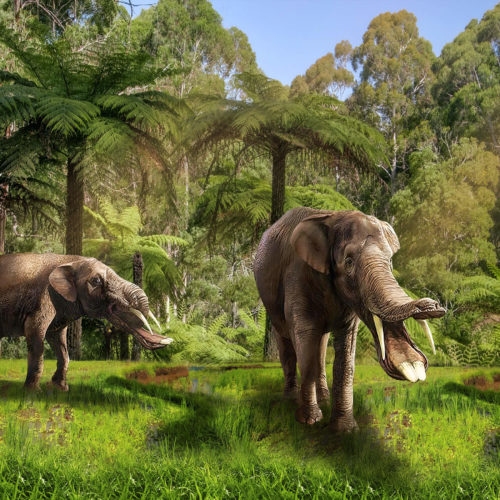
Weight: 22,000 lb. | Height: 7-10 ft. | Range: North America, North Africa
Description
Amebelodon is a genus of extinct proboscidean belonging to Amebelodontidae (the so-called shovel-tuskers), a group of proboscideans related to the modern elephants and their close relative the mammoth. The most striking attribute of this animal is its lower tusks, which are narrow, elongated, and distinctly flattened with the degree of flattening varying among the different species. Two valid species are currently placed within this genus, which was endemic to North America. Other species once assigned to Amebelodon are now assigned to the genus Konobelodon, which was once a subgenus.
Source: Wikipedia
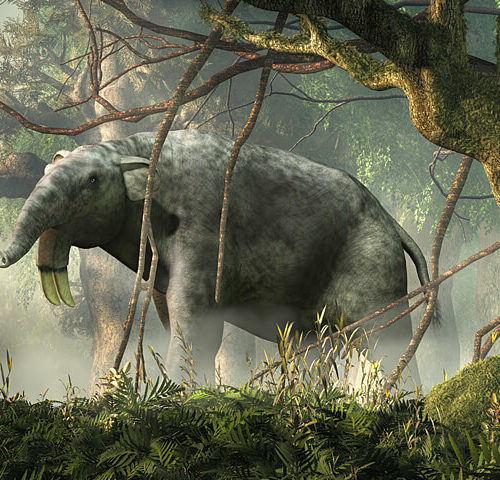
Weight: 26,000 lb. | Height: 7-10 ft. | Range: North America, North Africa
Description
Deinotherium ("terrible beast" derived from the Ancient Greek δεινός, deinos meaning "terrible" and θηρίον, therion meaning "beast") was a large prehistoric relative of modern-day elephants that appeared in the Middle Miocene and survived until the Early Pleistocene. During that time, it changed very little. In life, it probably resembled modern elephants, except it had downward-curving tusks attached to the lower jaw.
Source: Wikipedia
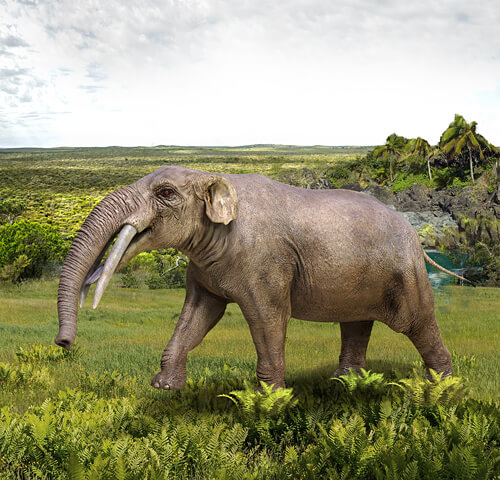
Weight: 10,000 lb. | Height: 10 ft. | Range: North America, Africa, Asia, Europe
Description
G. productum is known from a 35-year-old male 2.51 m (8 ft 3 in) tall weighing 4.6 t (4.5 long tons; 5.1 short tons). Even larger is G. steinheimense, known from a complete 37-year-old male found in Mühldorf, Germany, which is 3.17 m (10.4 ft) tall and weighed 6.7 t (6.6 long tons; 7.4 short tons). It had four tusks, two on the upper jaw and two on the elongated lower jaw. The lower tusks are parallel and shaped like a shovel and were probably used for digging up food from mud. Unlike modern elephants, the upper tusks were covered by a layer of enamel. Compared to elephants, the skull was more elongated and low, indicating that the animal had a short trunk, rather like a tapir's. These animals probably lived in swamps or near lakes, using their tusks to dig or scrape up aquatic vegetation. In comparison to earlier proboscids, Gomphotherium had far fewer molars; the remaining ones had high ridges to expand their grinding surfaces. Gomphotherium spp. inhabited dry wooded regions near lakes.
Source: Wikipedia
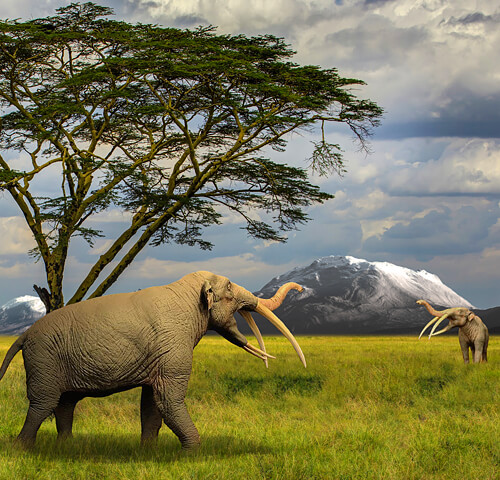
Weight: 26,000 lb. | Height: 13 ft. | Range: Africa, Asia, Europe
Description
Stegotetrabelodon is an extinct genus of primitive elephant with gomphothere-like anatomical features from the Late Miocene to Early Pliocene of Africa and Eurasia. The type species is S. syrticus of late Miocene Africa, which reached roughly 4 m (13.1 ft) in shoulder height and 11–12 tonnes (12.1–13.2 short tons) in weight. The other unequivocally recognized species is S. orbus, also of late Miocene Africa. Other species outside of Africa are questionably placed in this genus, including teeth from Late Miocene Hungary and Iran originally described as being of the Mastodon subgenus Bunolophodon, Chinese specimens originally described as being also of Mastodon, as well as of Tetralophodon and Stegodon, and a species from the late Miocene-aged Dokh Pathan Formation in Pakistan, S. maluvalensis.
Source: Wikipedia
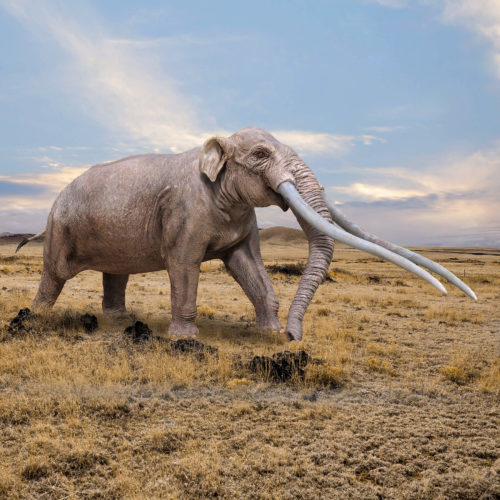
Weight: 28,000 lb. | Height: 13 ft. | Range: Asia, East Africa, Central Africa
Description
Stegodon, meaning "roofed tooth" (from the Ancient Greek words στέγω, stégō, 'to cover', + odoús, 'tooth') because of the distinctive ridges on the animal's molars, is a genus of the extinct subfamily Stegodontinae of the order Proboscidea. It was assigned to the family Elephantidae (Abel, 1919), but has also been placed in the Stegodontidae (R. L. Carroll, 1988). Stegodonts were present from 11.6 million years ago (Mya) to the late Pleistocene, with unconfirmed records of localized survival until 4,100 years ago. Fossils are found in Asian and African strata dating from the late Miocene; during the Pleistocene, they lived across large parts of Asia and East and Central Africa, and in Wallacea as far east as Timor. Stegodon’s ivory displayed at Philippine National Museum.
Source: Wikipedia
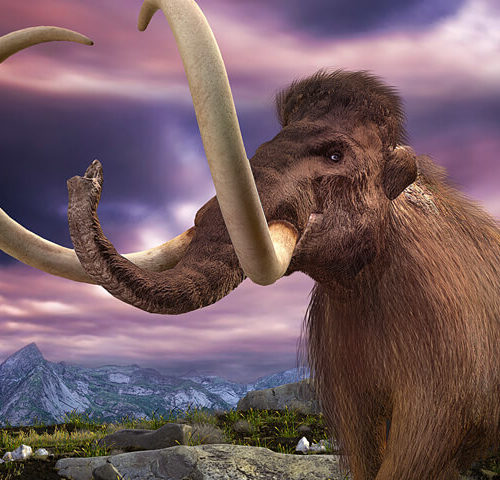
Weight: 12,000 lb. | Height: 10 ft. | Range: North America, Europe, Asia
Description
A mastodon (Greek: μαστός "breast" and "tooth") is any proboscidean belonging to the extinct genus Mammut (family Mammutidae) that inhabited North and Central America during the late Miocene or late Pliocene up to their extinction at the end of the Pleistocene 10,000 to 11,000 years ago. Mastodons lived in herds and were predominantly forest-dwelling animals that lived on a mixed diet obtained by browsing and grazing, somewhat similar to their distant relatives, modern elephants, but probably with greater emphasis on browsing. M. americanum, the American mastodon, and M. pacificus, the Pacific mastodon, are the youngest and best-known species of the genus. Mastodons disappeared from North America as part of a mass extinction of most of the Pleistocene megafauna, widely believed to have been caused by overexploitation by Clovis hunters.
Source: Wikipedia
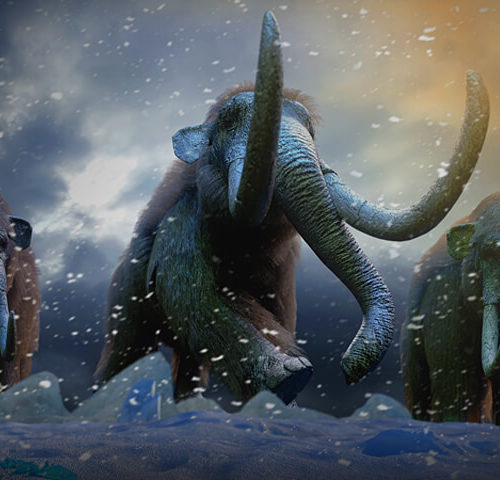
Weight: 9,000 lb. | Height: 11 ft. | Range: North America, Europe, Asia
Description
The woolly mammoth (Mammuthus primigenius) is an extinct species of mammoth that lived during the Pleistocene until its extinction in the early Holocene epoch. It was one of the last in a line of mammoth species, beginning with Mammuthus subplanifrons in the early Pliocene. The woolly mammoth began to diverge from the steppe mammoth about 800,000 years ago in East Asia. Its closest extant relative is the Asian elephant. The appearance and behavior of this species are among the best studied of any prehistoric animal because of the discovery of frozen carcasses in Siberia and Alaska, as well as skeletons, teeth, stomach contents, dung, and depiction from life in prehistoric cave paintings. Mammoth remains had long been known in Asia before they became known to Europeans in the 17th century. The origin of these remains was long a matter of debate, and often explained as being remains of legendary creatures. The mammoth was identified as an extinct species of elephant by Georges Cuvier in 1796.
Source: Wikipedia
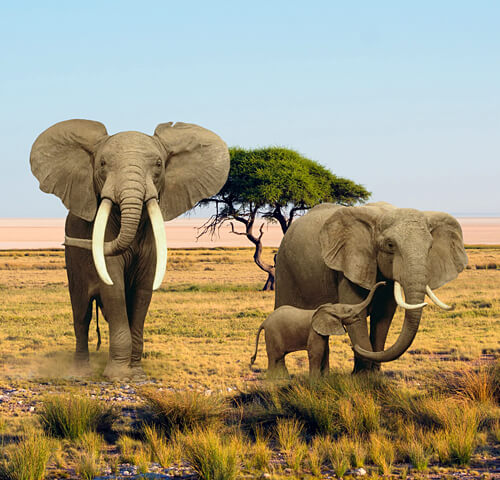
Weight: 9,000 - 13,000 lb. | Height: 9 - 13 ft. | Range: Asia, Africa
Description
The Asian elephant (Elephas maximus), also called Asiatic elephant, is the only living species of the genus Elephas and is distributed throughout the Indian subcontinent and Southeast Asia, from India in the west, Nepal in the north, Sumatra in the south, and to Borneo in the east. Three subspecies are recognised—E. m. maximus from Sri Lanka, E. m. indicus from mainland Asia and E. m. sumatranus from the island of Sumatra. The Asian elephant is the largest living land animal in Asia. The African elephant (Loxodonta) is a genus comprising two living elephant species, the African bush elephant (L. africana) and the smaller African forest elephant (L. cyclotis). Both are herbivores and live in groups. They have grey skin and differ in the size of their ears and tusks, and in the shape and size of their skulls. Loxodonta is one of two existing genera of the family Elephantidae. The name refers to the lozenge-shaped enamel of their molar teeth. Fossil remains of Loxodonta species have been excavated in Africa, dating to the middle Pliocene.
Source: Wikipedia
extinction
woolly mammoths went extinct 10,000 years ago
Most populations of the woolly mammoth in North America and Eurasia, as well as all the Columbian mammoths (M. columbi) in North America, died out around the time of the last glacial retreat, as part of a mass extinction of megafauna in northern Eurasia and the Americas. Until recently, the last woolly mammoths were generally assumed to have vanished from Europe and southern Siberia about 12,000 years ago, but new findings show some were still present there about 10,000 years ago. Slightly later, the woolly mammoths also disappeared from continental northern Siberia. A small population survived on St. Paul Island, Alaska, up until 3750 BC, and the small mammoths of Wrangel Island survived until 1650 BC.
Source: National Geographic



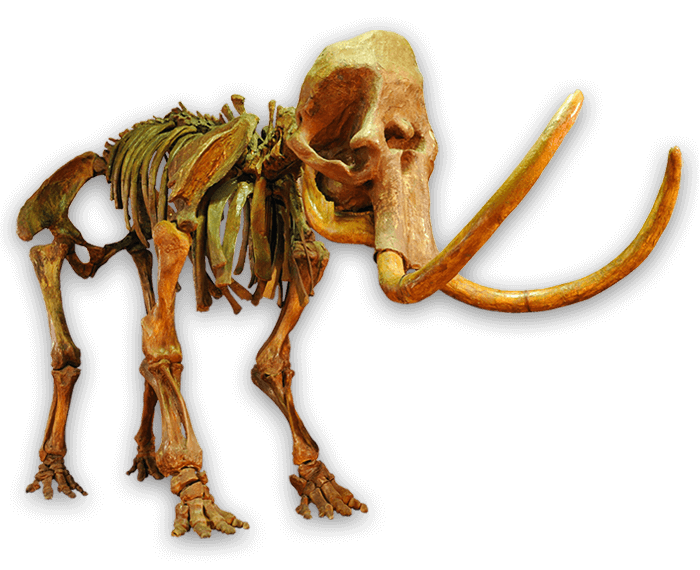

Lifespan
An average lifespan of woolly mammoth was 60 years, similar to modern-day African elephant.
Digestive Tracts
Remains of arctic plants have been found in the digestive tracts of frozen mammoth carcasses.
Complete Skeleton
First complete skeleton of woolly mammoth was found in 1799 by Wilhelm Gottlieb Tilesius von Tilenau.
Tough Tusks
Woolly mammoth had large, curved and asymmetrical tusks that were 10 to 15 feet long.
![]() When did mammoths go extinct?
When did mammoths go extinct?
The vast majority of woolly mammoths died out at the end of the last ice age, about 10,500 years ago. But because of rising sea levels, a population of woolly mammoths became trapped on Wrangel Island and continued living there until their demise about 3,700 years ago.
![]() Why did mammoths die out?
Why did mammoths die out?
Some experts think mammoths were hunted to extinction by the species that was to become the planet’s dominant predator – humans. Others argue that climate change was more responsible. A 2016 study suggests that one of the last known groups of woolly mammoths died out because of a lack of drinking water.
resurrection
mammoth dna helps explain why the species went extinct
Reviving the woolly mammoth is still a tall order. However, technology might be far enough along to help explain why the elephant precursor went extinct in the first place. Scientists have ‘resurrected’ genes from a population of mammoths that survived on a Siberian island until around 4,000 years ago to see what might have contributed to this relic herd dying out. After resurrecting a mammoth’s genes through cells in culture, they compared it against both other mammoths and Asian elephants to look for problematic mutations based on known genetic behavior.
As it turns out, at least one of the island’s mammoths had a string of genetic defects. There were issues with male fertility, neurological development, insulin signalling and even the ability to smell flowers. This suggests the mammoths might have been hurt by their small population size (300 to 500) and isolation from the Siberian mainland, reducing their long-term chances of survival.
This doesn’t provide a full explanation for why woolly mammoths finally died out. Most of them (along with other species) were wiped out by a changing climate that eliminated the tundra they needed to survive. It paints a clearer picture, though, and suggests technology could help solve other prehistoric mysteries.
Now that researchers have sequenced mammoth genomes (although some of these genomes might be contaminated, according to a March 2017 study in the journal PLOS Genetics), could they clone a mammoth using somatic cell nuclear transfer — the process used to make Dolly the sheep? With somatic cell nuclear transfer, scientists extract the cell nucleus (which contains DNA) from an animal, called the donor. They then insert that nucleus into the egg cell, which has had its own nucleus removed, of another animal.
Source: Engadget
Xhilarate is a design and branding agency in Philadelphia that creates visual brand experiences that engage people, excite the senses and inspire our inner awesome. We are the arsenal of innovation. Xhilarate is a design consultancy dedicated to creating innovative brand and interactive experiences with an unyielding passion to create the extraordinary.
© 2020 Xhilarate Inc. All Rights Reserved.

